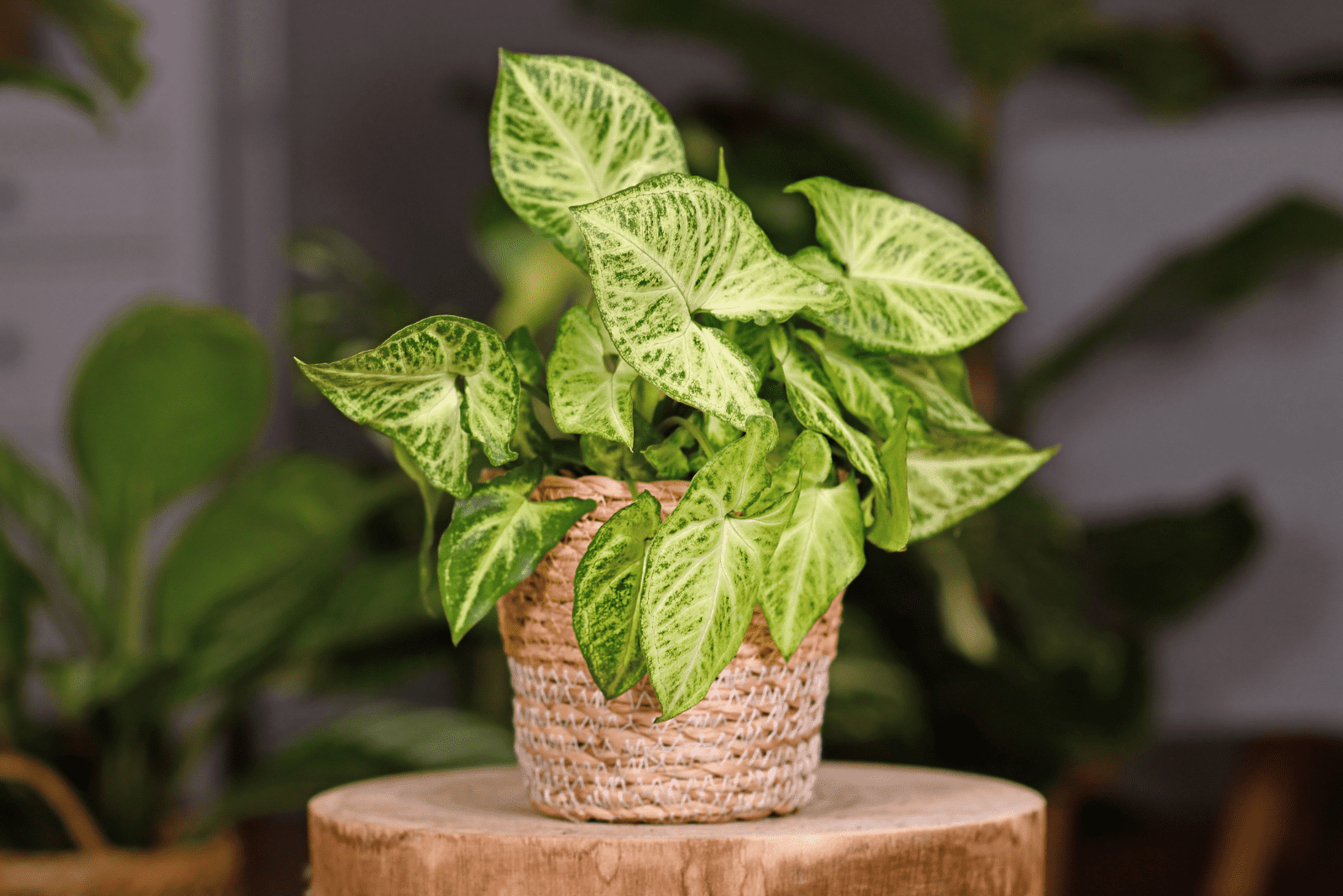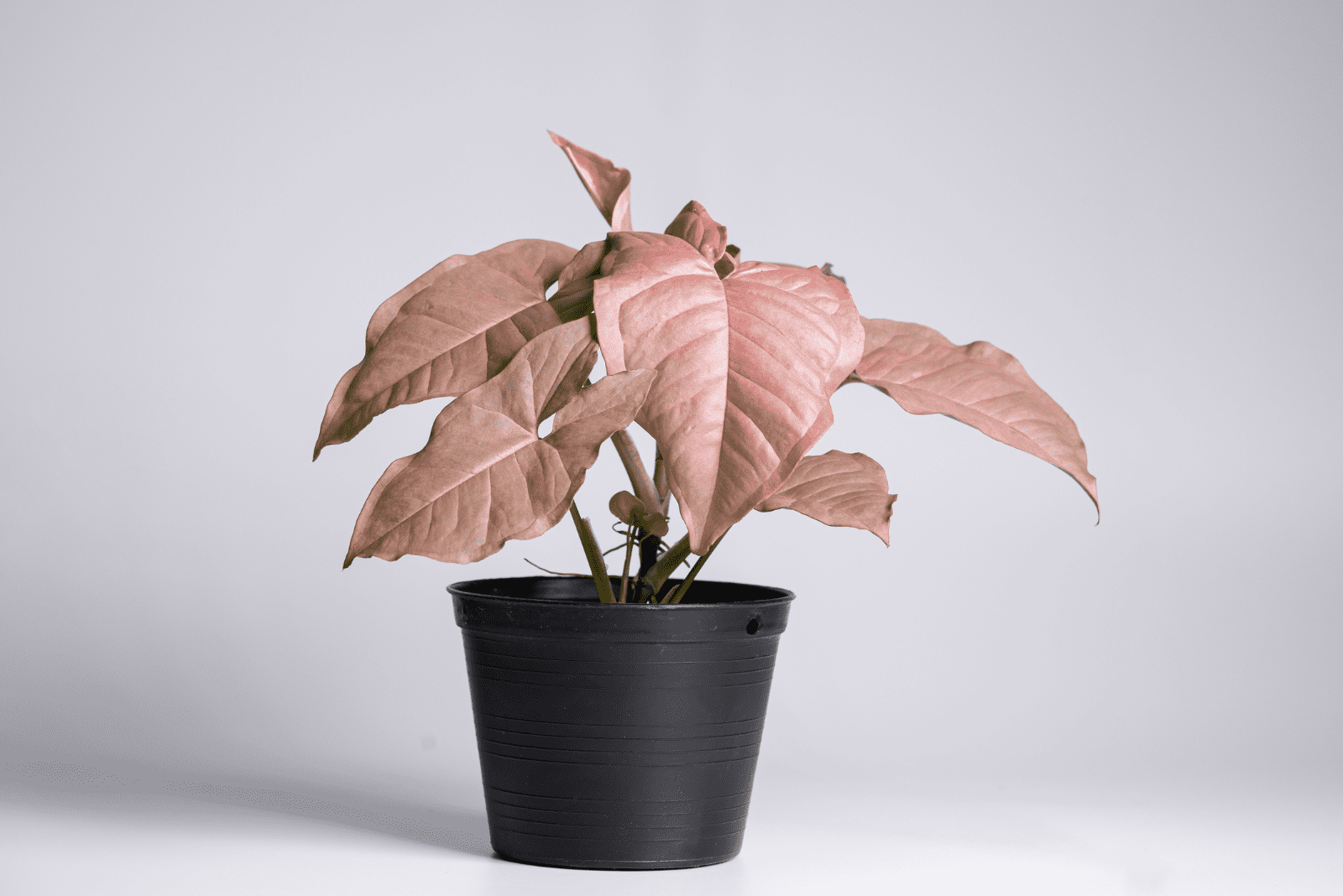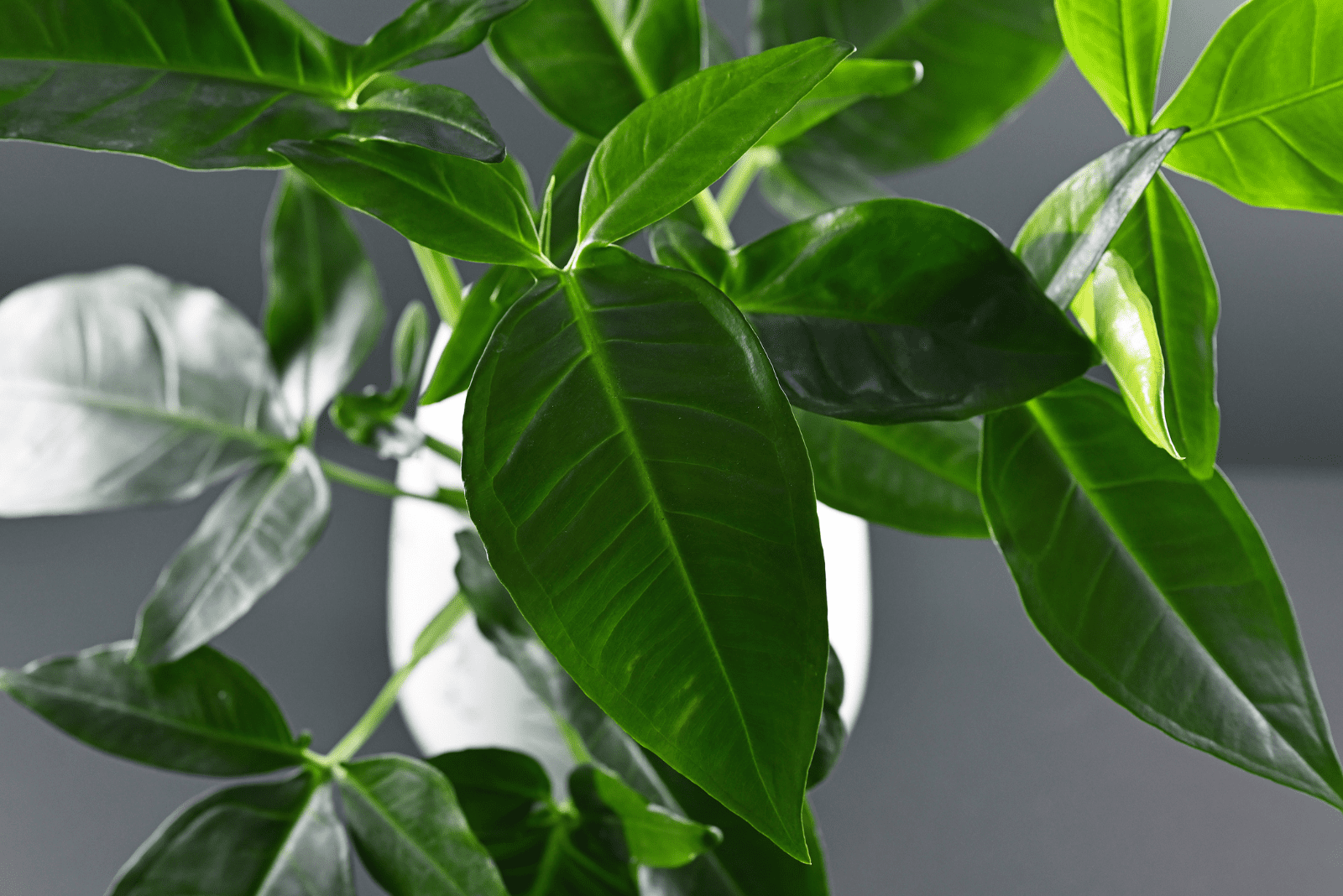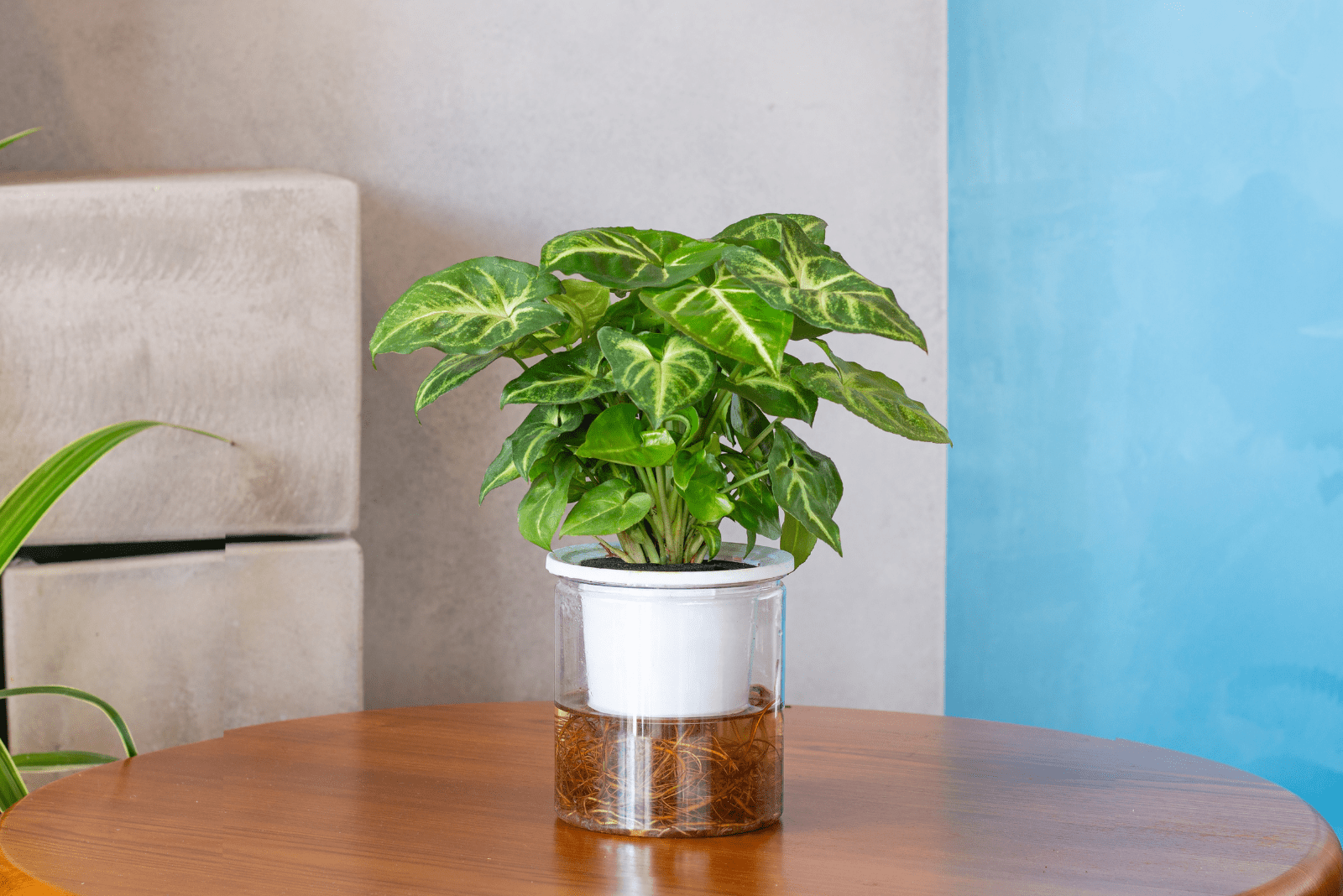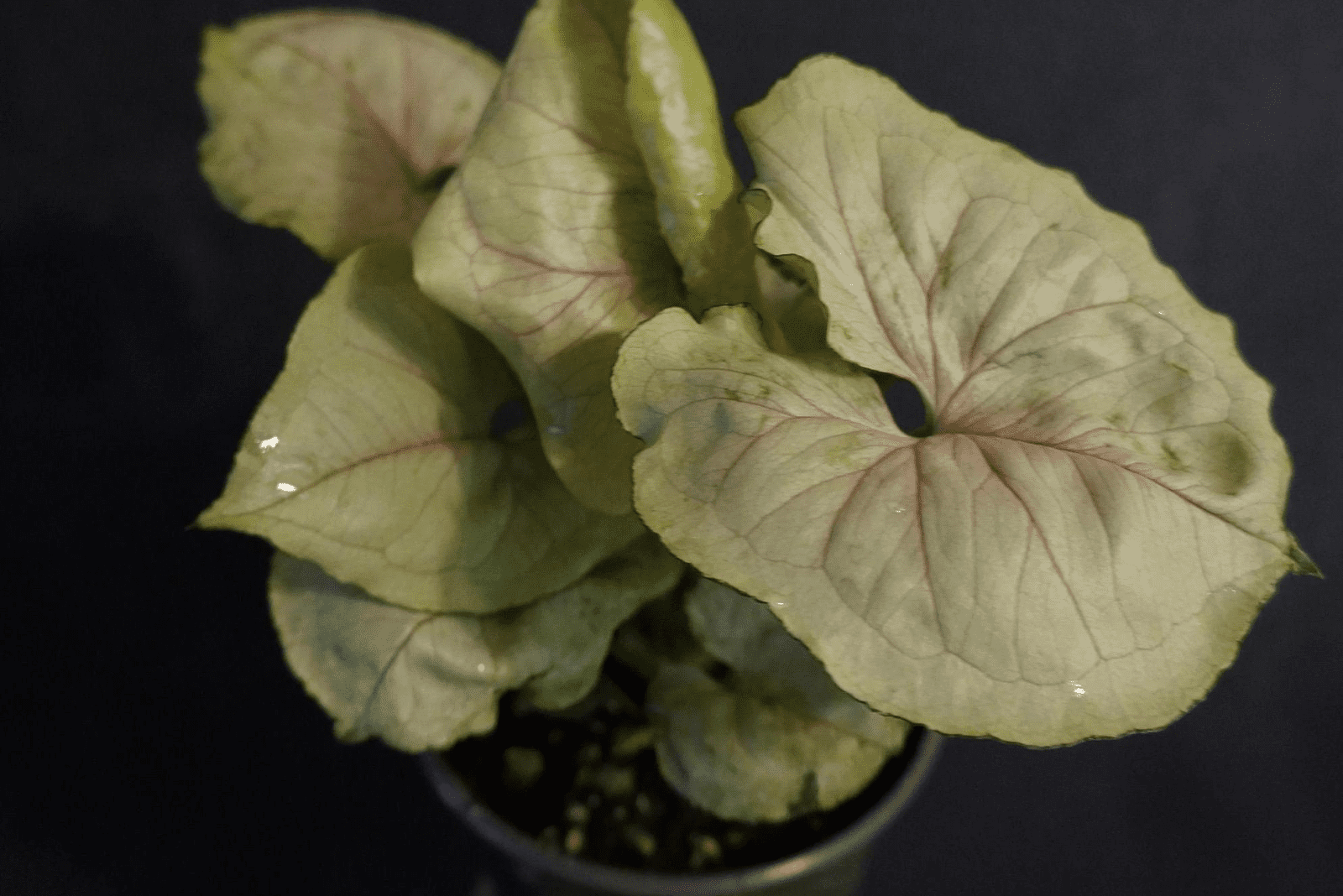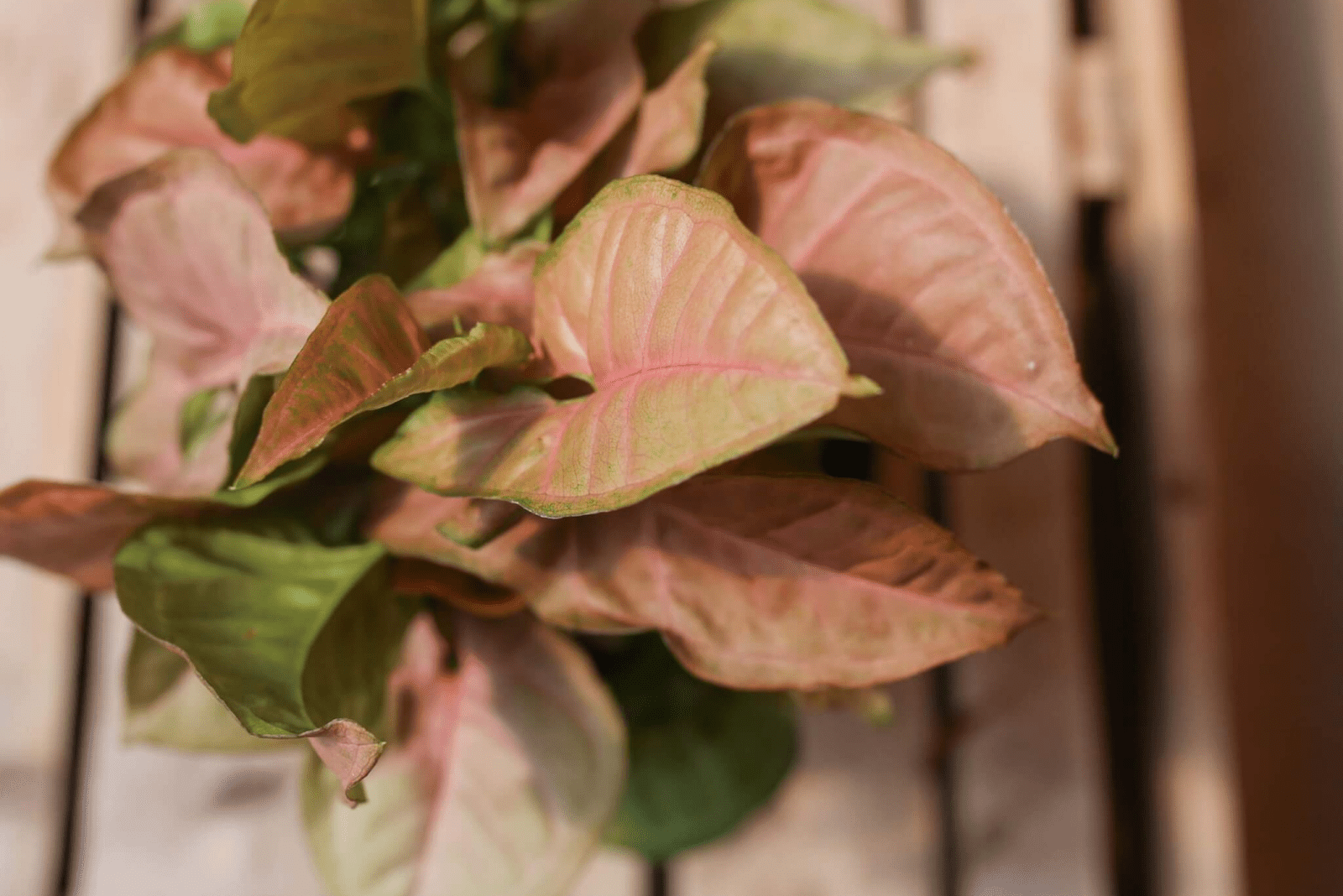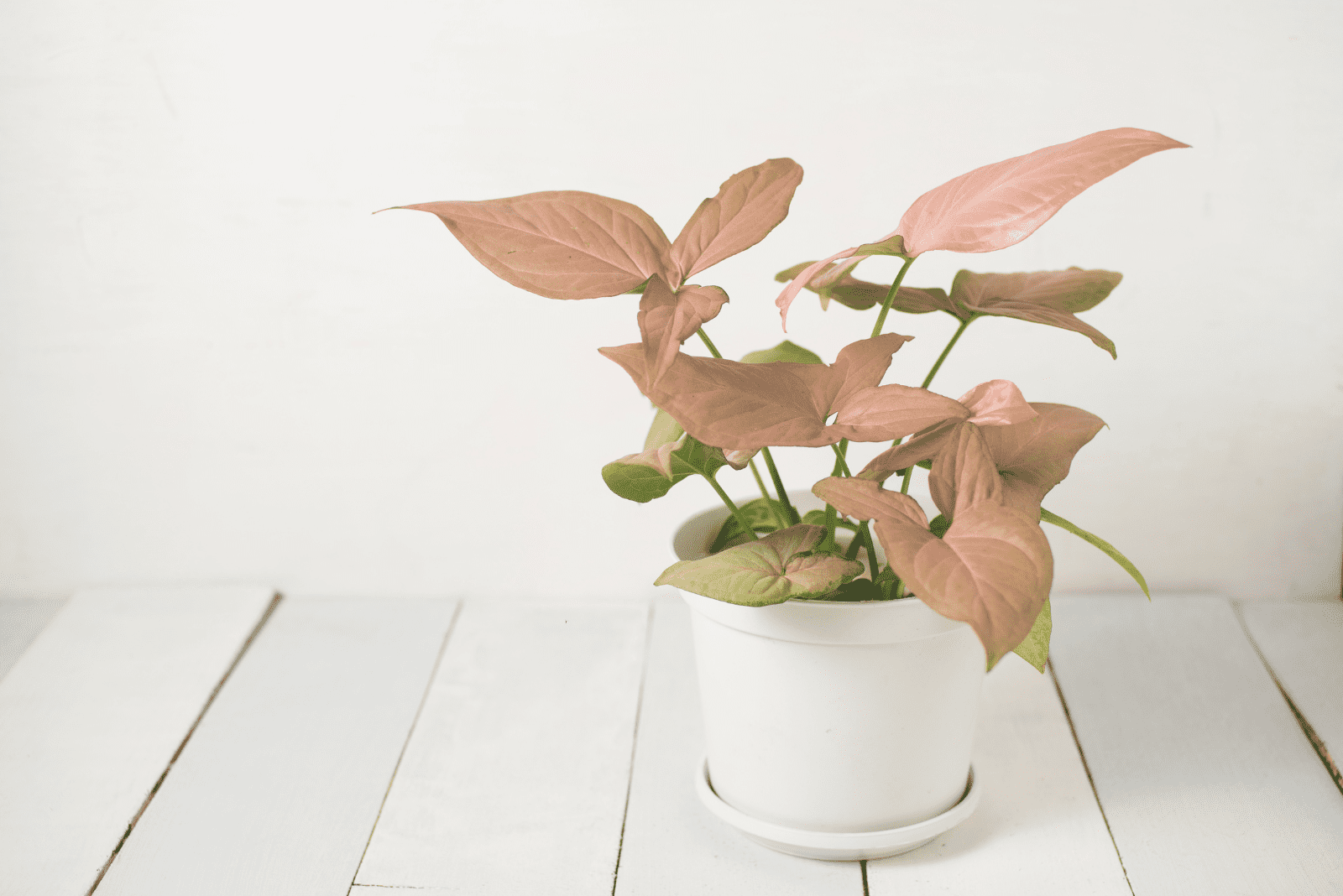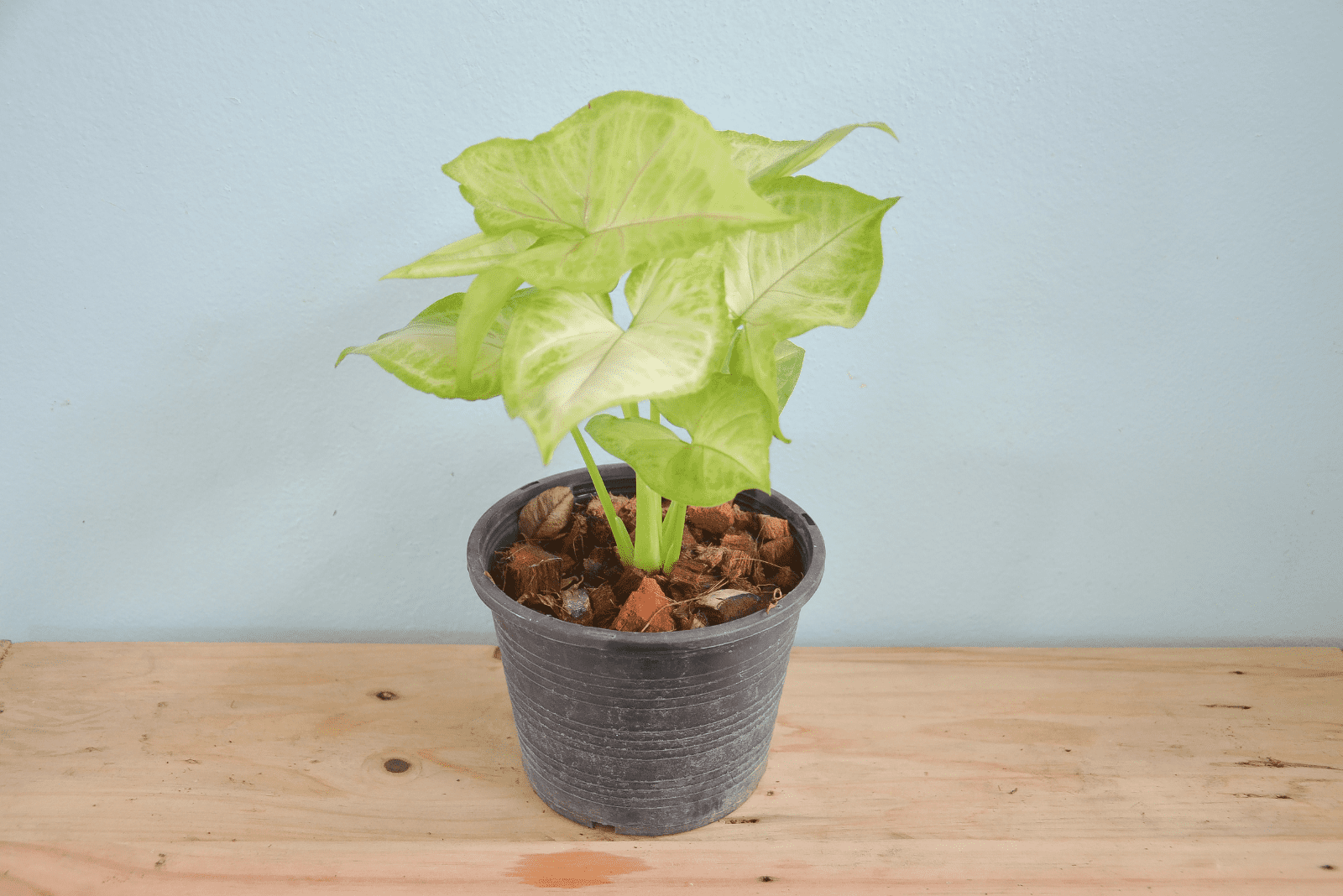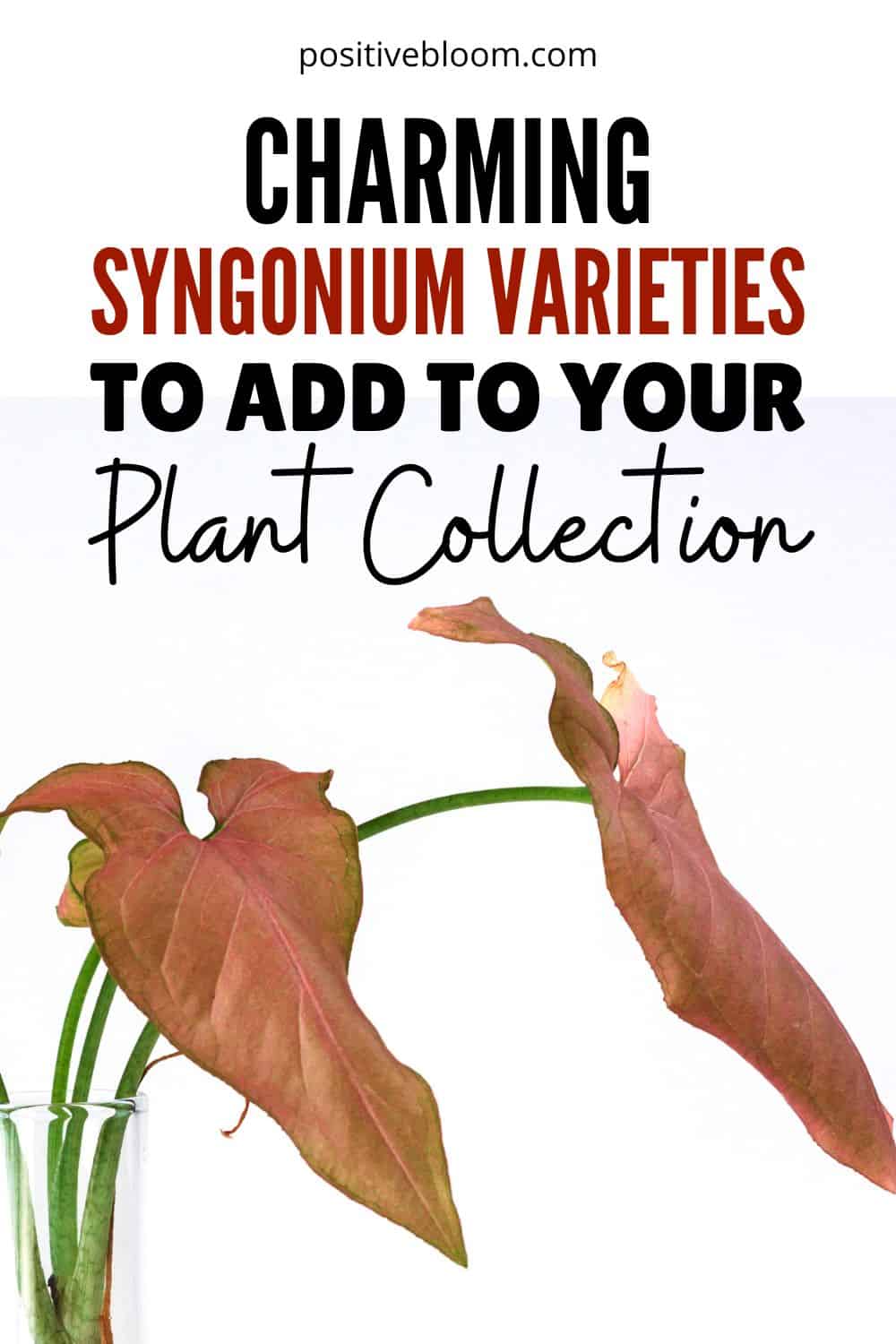Syngonium plants are captivating and frequently seen in houses around the world. They are hard to kill, but also considered air purifiers.
These lovely plants have arrow-shaped leaves, hence the name arrowhead plants. They’re fast growing and have a vining or climbing growth habit. When grown as houseplants, they look best in hanging baskets.
Syngonium plants belong to the Araceae family and are native to Mexico, Central and South America, and the West Indies.
In this article, I’ll show you several breathtaking Syngonium varieties and tell you more about their features and care requirements.
Let’s get started!
Syngonium Varieties
Syngonium podophyllum plants are the most commonly grown indoor plants when it comes to this genus.
I’ll first show you the most popular podophyllum plants, and then I’ll also tell you more about other types of Syngonium.
Let’s get into details!
Syngonium Podophyllum ‘Pink Allusion’
The first variety of Syngonium I’ll describe is the S. Podophyllum Pink Allusion. It features arrow-to-heart-shaped leaves that are pale pink on the surface and have green undersides. The leaves have noticeably darker pink veins.
Once a Pink Allusion matures, it may reach 6 feet in height and 2 feet in width.
Although this is a flowering plant, unfortunately, it rarely blooms if grown indoors.
It’s a perfect plant for beginners and makes a great gift. You can grow it in a hanging basket or train it to climb on a trellis or other similar structure.
Your Pink Allusion will tolerate low light, but be careful not to overwater it.
Syngonium Podophyllum ‘Emerald Gem’
Here’s one Syngoinum variety for lovers of green leaves, the S. Podophyllum Emerald Gem. This variety is a true gem; it comes in a standard and variegated version.
The standard Emerald Gem has emerald green leaves, whereas the variegated version features dark to light green leaves. The leaves have accentuated white veins, making them a sight to behold.
Both varieties have similar care requirements, but you’ll need to pay attention to how much light you give to a variegated Emerald Gem.
As you may know, variegated plant varieties need more light as their leaves lack green pigment.
Syngonium Podophyllum ‘White Butterfly‘
The White Butterfly is another American evergreen, and is a Syngonium podophyllum cultivar. The leaves come in creamy white and green colors, and the arrow shape makes the plant resemble butterflies, hence the name.
This variety requires a little maintenance and will make a perfect addition to any home and plant collection.
If you live in a warm climate, you can grow the White Butterfly outdoors and let the vines cascade down from hanging baskets on the porch.
Syngonium Podophyllum ‘Trileaf Wonder’
Another attractive Syngonium plant is the Trileaf Wonder. Juvenile Trileaf Wonder plants produce light green leaves, which become glossy and dark green as they mature.
Interestingly, the leaves of this plant split into three lobes when fully mature, hence the nickname.
This low-maintenance Syngonium grows up to 2.5 feet tall.
If you want your Trileaf Wonder to be a bit bushier, you can prune the vines to get the desired shape.
Syngonium Podophyllum ‘Exotic Allusion’
If you want to add an exotic touch to your plant collection or garden, then an S. podophyllum Exotic Allusion is what you need.
This is a truly unique variety with light green leaves and dark green edges. The leaves of the Exotic Allusion have creamy-white veins, which make the plant stand out.
The Exotic Allusion is a trailing plant, and I recommend attaching it to a trellis. Ensure a lot of bright indirect light for this attractive variety.
Syngonium Podophyllum ‘Neon Robusta’
If I had to choose my top three Syngonium varieties, Syngonium podophyllum Neon Robusta would definitely be on the list.
This arrowhead vine looks perfect in hanging baskets, but you can always plant it in a sizable pot and stake it.
The Neon Robusta features neon pink leaves that can sometimes have light green variegations. The leaves are heart-shaped when juvenile, and get their famous arrowhead shape when they mature.
The more bright light you give to the Neon Robusta, the more variegation it will have. However, direct sunlight may destroy the leaves, so make sure the light is bright and indirect.
Syngonium Podophyllum ‘Pixie’
If you’re looking for a plant for your dining table, meet the S. Podophyllum Pixie – a lovely dwarfish arrowhead vine variety.
The leaves of the pixie have deep-green edges and white to light green variegations. This Syngonium can reach up to 10 inches tall, but needs pruning to maintain a compact shape.
The Syngonium Pixie is native to rainforests, so you need to ensure high humidity to meet its needs.
Syngonium Podophyllum ‘Confetti’
Another American evergreen is the cheerful S. podophyllum Confetti. The name fits perfectly, as the light green leaves of the Confetti variety have pink freckles.
This variety looks amazing when supported with a pole or attached to a trellis.
The Syngonium Confetti is a tropical plant, so you’ll need to ensure similar conditions to those found in rainforests.
Ensure bright indirect light and high humidity for your Confetti to thrive.
Syngonium Podophyllum ‘Maria Allusion’
Here comes another attractive Syngonium plant, the S. podophyllum Maria Allusion.
If you live in a warm region, the Maria Allusion Syngonium makes a great ground cover.
When compared to other Syngonium varieties, the Maria Allusion has unique leaf colors. The leaves are primarily green, but have hints of red or bronze with accentuated pinkish-red veins.
Interestingly, when new leaves emerge they are pinkish-red, and as they mature they take on a greener color.
The Syngonium Maria Allusion reaches up to 2 feet in height and 1.5 feet in width.
You can prune it more frequently to promote new growth and keep it compact.
Syngonium Podophyllum ‘Bold Allusion’
Another arrowhead vine is the S. podophyllum Bold Allusion. The leaves are broad and light green with dark green edges and noticeable pink veins.
It’s mainly grown as an ornamental plant, and may reach up to 14 inches in height.
This green-painted arrow plant is pretty easy to care for; you need to ensure warm temperatures, high humidity, bright indirect light, and well-draining soil to avoid root rot.
It will benefit from monthly fertilization; an all-purpose balanced fertilizer diluted to half strength will suffice.
Syngonium Podophyllum ’Mottled Mojito’
If you’re looking for another exotic Syngonium, you’ll love the Mottled Mojito – a splendid Syngonium podophyllum cultivar.
It has arrow-shaped leaves that are mottled with deep green and a brighter, creamy green.
The Mottled Mojito Syngonium will look amazing in any part of your home; it will tolerate lower light, but it’s a variegated Syngonium, so aim for bright indirect light.
You can boost the growth of this Syngonium by applying slow-release fertilizer at the beginning of the growing season.
It will look amazing next to any of the pink Syngonium plants. In my humble opinion, no other houseplant can outshine the Mottle Mojito Syngonium!
Syngonium Podophyllum ‘Holly’
Some Syngonium varieties are pretty hard to find on the market. One such variety is the S. podophyllum Holly.
This variety doesn’t have pure green leaves, instead they are silvery-white with green veins.
This is another compact variety that needs moderate humidity and warmer temperatures to thrive.
Syngonium Podophyllum ‘Berry Allusion’
The Berry Allusion is another Syngonium podophyllum variety. It’s characterized by pale-green leaves and noticeable green veins.
It’s a pretty tall variety that may grow up to 9 feet when cultivated as a houseplant.
You can prune it to control the size if you are short on space.
If you decide to grow a Berry Allusion Syngonium, be careful not to expose it to low temperatures. Even an hour spent in freezing temperatures will quickly kill your plant, and I’m not exaggerating!
Syngonium Podophyllum ‘Cream Allusion’
The last Allusion Syngonium I’ll tell you more about is the Cream Allusion. It makes a perfect indoor plant and may tolerate slightly lower light levels.
However, it may lose its variegations if it doesn’t receive enough bright indirect light.
It features pale green leaves with dark green edges and lovely pink veins.
It thrives best in moist soil, but never let the plant sit in soggy soil as its roots could quickly rot.
I recommend watering your Cream Allusion Syngonium once the topsoil dries out.
Syngonium Podophyllum ‘Green Gold’
I present to you a majestic Syngonium plant – the S. podophyllum Green Gold. It features dark green leaves with unique golden veins.
Some plant aficionados claim that this Syngonium plant is more demanding in terms of plant care compared to other varieties.
The Green Gold Syngonium may grow up to 6 feet tall and 2 feet wide as a trailing plant.
Syngonium Podophyllum ‘Strawberry Cream’
Now I would like to tell you more about the Syngonium plant that probably has the most beautiful leaf color.
As the Strawberry Cream plant grows, the spectacular leaves may transition from an initial creamy pink hue to a green tint with pink veins.
Growers decided to cultivate the Strawberry Cream as it’s highly adaptable to an indoor setting. However, be careful with the light level as the delicate leaves of this Syngonium can’t withstand intense sun rays.
Bright indirect light, well-draining soil, warmer temperatures, and high humidity is all the Strawberry Cream needs to thrive.
I recommend supporting this cultivar with a moss pole or something similar to accentuate its beauty and promote growth.
Syngonium Erythrophyllum
I’ve covered the most popular varieties of Syngonium podophyllum, and now I would like to tell you more about the magnificent Syngonium Erythrophyllum!
It’s a very different Syngonium plant than what we are used to seeing in plant collections. The surface of the leaves is dark green, but the undersides are burgundy or deep red, which really makes the plant stand out.
Broad, lighter green leaves with a bright crimson underside are a characteristic of young plants. The leaves will develop a more distinct arrowhead shape as the plant ages, and become a deeper green with deep red or burgundy undersides.
This plant is native to tropical rainforests, so it cannot withstand cold temperatures or frost. Due to temperature injury and tissue damage brought on by exposure to frost or extremely low temperatures, the plant will perish.
Syngonium Wendlandii
Another famous variety of Syngonium is the Wendlandii. You’ll commonly find this cultivar under the name Silver Goosefoot plant.
The Wendlandii plant got that nickname as its young leaves resemble goose feet.
Of course, as Wendlandii plants mature, their leaves will get their popular arrow shape. Glossy, deep green leaves with white veins are the reason many growers decide to grow a Wendlandii.
What makes this Syngonium special is that it blooms if grown outdoors. The flowers are white and have a broad base.
Only mature Wendlandii produce flowers, and you have a bigger chance of seeing the flowers outdoors if you attach the plant to a trellis.
Syngonium Angustatum ‘Five Finger’
The Syngonium Five Finger is another lovely American evergreen.
How did this Syngonium angustatum get the name Five Finger? Interestingly, this Syngonium has five sections; two sections are placed at the base of the leaf stem, one thin section is in the middle, and two sections are at an angle to the middle section.
The glossy green leaves have vibrant pink on them, but the pink disappears eventually, and adult Five Finger leaves remain green.
The Syngonium angustatum Five Fingers may grow up to 12 to 15 inches in length and 8 inches in width.
Syngonium Facts & Short Care Guide
Growing and caring for Syngonium plants is pure joy! Before I share some care tips with you, I would like to tell you some facts about Syngoniums, and why they are commonly grown as houseplants.
Syngonium Facts
First, Syngonium plants come under the names arrowhead plants and arrowhead vines. They belong to the Araceae family and have their own genus – Syngonium.
They are native to tropical rainforests and produce aerial roots, which help them climb taller trees.
This is the reason these plants grow well if supported by moss poles or attached to trellises. Syngoniums produce vines and look stunning when grown in hanging baskets.
Benefits
These plants are air purifiers, which means a Syngonium in your room will remove toxic substances, such as toluene and benzene.
Syngonium plants increase relative indoor humidity; therefore, if you have issues with allergies or an itchy throat, the Syngonium is here to help.
The Syngonium is an excellent Feng Shui plant. For lovers of this art, these plants are a perfect choice. As mentioned, Syngonium plants feature five-lobed leaves, and this symbolizes five elements: in Feng Shui, water, earth, metal, fire, and wood, and it creates the ideal Yin-Yang balance because younger leaves are glossy, and older ones are matte.
It also promotes good Chi. It would be best if you placed your Syngonium in the east or southeast to activate wood energy. It will help you with inspiration, so placing it in your office is an excellent idea.
Another great feature of Syngonium plants is their ease of propagation. You simply take a stem cutting and root it in water or soil.
I don’t even need to tell you about the beauty of these plants. They are cultivated mainly as ornamental plants, but there are many other great reasons to add them to your plant collection.
Drawbacks
There’s no such thing as perfection. Syngonium plants are toxic to humans and pets, which is the only drawback of this plant.
The crystals of calcium oxalate found in the leaves of these plants may cause severe damage to humans and pets if ingested.
Syngonium poisoning results in swelling, gastrointestinal pain, oral irritation, and, in extreme cases, breathing and swallowing issues.
If you have any difficulties, get in touch with your doctor!
Short Care Guide
Now that you know the varieties of Syngonium, and the plant benefits and drawbacks, I would like to share a few care tips to help your Syngonium thrive.
1. Arrowhead vine plants prefer bright indirect light. If given insufficient light, your Syngonium is prone to become leggy. Its color may fade, and some cultivars may lose variegations. However, these plants despise direct sun, so it’s better to keep them in shadier spots than in the full sun.
2. Syngonium species perform best in a temperature range of 60-80 degrees Fahrenheit. They won’t tolerate temperatures below 50 degrees Fahrenheit.
3. Arrowhead plants enjoy high humidity levels; the best range is from 60 to 90%. Mist your Syngonium, place a pebble tray below the pot, use a humidifier, or group it with other houseplants, such as Philodendrons, to increase humidity levels.
4. Your Syngonium thrives in moist soil; as soon as you notice the topsoil is dry, water your plant. Be careful not to keep the soil overly wet as it could induce root rot.
5. Use well-draining, fertile, and slightly acidic soil for your Syngonium. Amend the soil with porous and well-draining materials such as perlite and vermiculite.
FAQs
Which Syngonium plant is best?
It mainly depends on the shape and color you prefer. If you are more into classic green-leaf plants, then the Syngonium Emerald Gem is a good choice.
If you are looking for a variegated cultivar, then the Syngonium Cream Allusion is a perfect choice.
Some Syngonium plants have entirely pink leaves, such as Syngonium Pink Allusion or Syngonium Neon Robusta.
If you are looking for reddish varieties, then Maria Allusion Syngonium is my recommendation.
Which Syngoniums are poisonous?
All plants from the Syngonium genus are toxic to humans and pets. All Syngonium plant parts contain toxic substances known as calcium oxalate crystals. Poisoning occurs after ingestion, which activates the crystals. The symptoms include gastrointestinal pain, swelling, oral irritation, and heavy breathing (severe cases).
What are some other names for the Syngonium?
The most common name for Syngonium plants is arrowhead plants. You can also find these plants under the names arrowhead vines, gooseplants, Nephthytis, American evergreen, and African evergreen. Each species has a nickname or two, depending on the distinctive shape or color. You may often come across the name pink Syngonium, which refers to species with pink color on the leaves (spots or entire leaves).
What is the average price of a Syngonium Three Kings?
The average price of a Syngonium Three Kings is about $30. However, this species is pretty rare, so you may have trouble finding one in local plant stores. Try looking for a Three Kings Syngonium online as you’ll have a better chance.
Wrapping Up
Syngonium plants are definitely in the top 5 of every grower. Many beginner growers choose a Syngonium as their first plant.
This fact isn’t surprising because these plants look incredible. But what makes them even more desirable is the ease of maintenance; they are REALLY hard to kill.
After reading this article and discovering all these amazing Syngonium varieties, I’m sure you’ll find one (or more) to add to your plant collection.
Enjoy growing your Syngonium!
Until next time!
Like this post? Share or pin it for later!

